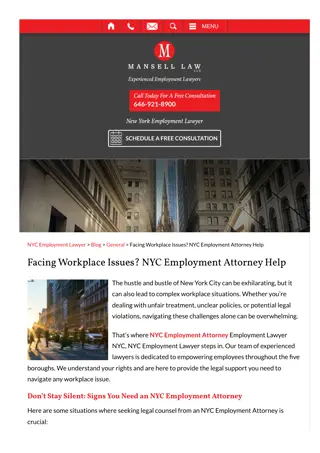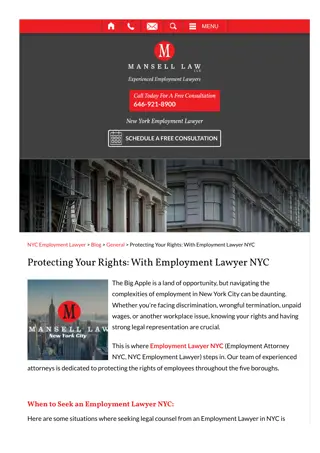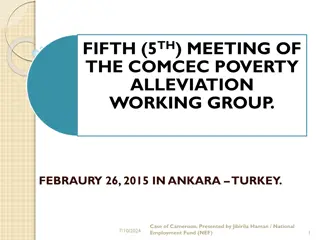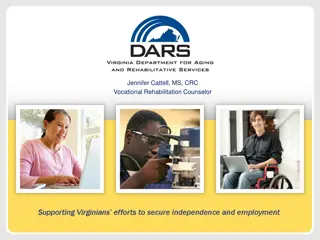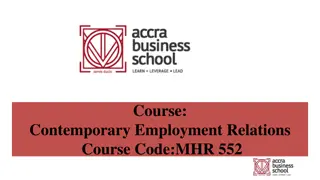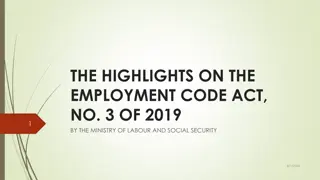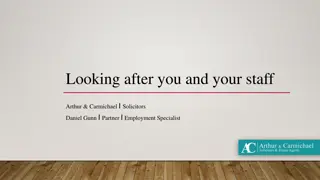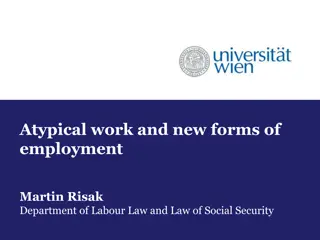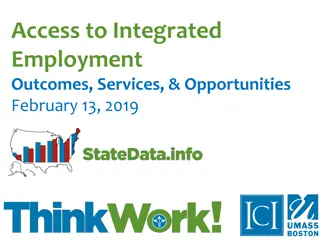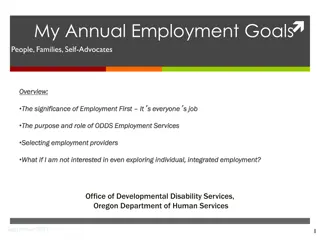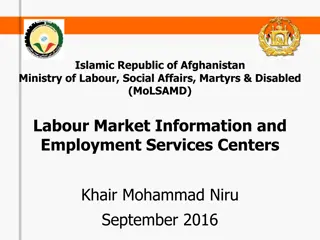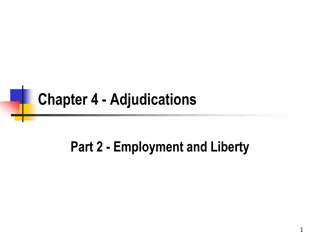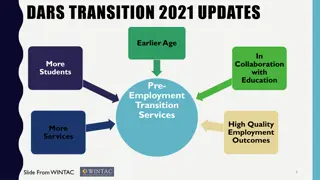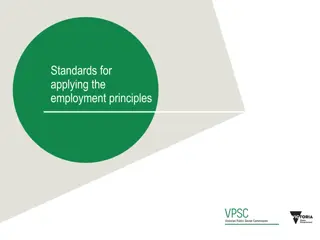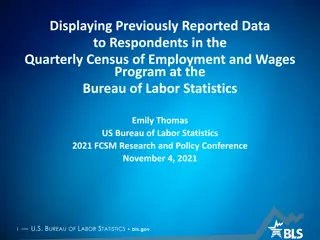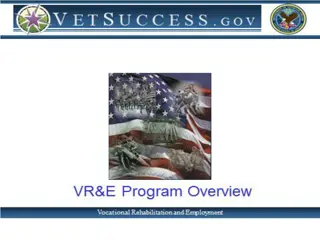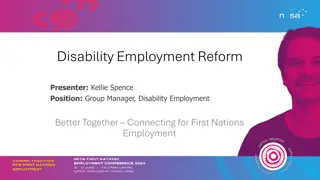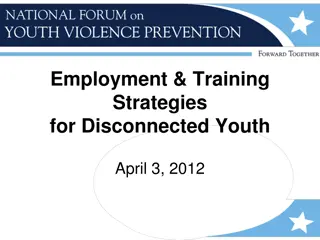Effective Documentation Practices for Employment Decisions
Documentation practices are crucial for supporting employment decisions, such as hiring, promotion, evaluation, and discipline. Good documentation provides clarity, reveals behavioral patterns, aids memory, and supports successors. It also establishes a record of action, prevents denial of events, increases credibility, and provides evidence of fair treatment. Various types of documentation, including policies, letters, memoranda, and corrective action plans, play a vital role in this process.
Download Presentation

Please find below an Image/Link to download the presentation.
The content on the website is provided AS IS for your information and personal use only. It may not be sold, licensed, or shared on other websites without obtaining consent from the author. Download presentation by click this link. If you encounter any issues during the download, it is possible that the publisher has removed the file from their server.
E N D
Presentation Transcript
DOCUMENTATION PRACTICES THAT SUPPORT EMPLOYMENT DECISIONS PREPARED AND PRESENTED BY JACQUELYN ARCHULETA-STAEHLIN AMANDA NELSON
AGENDA Documentation 3 34 Investigations 35 38 Insubordination, Conduct, Misconduct 39 41 Media Issues 42 43 2
EFFECTIVE SUPERVISIONAND EVALUATION Know your professional and legal obligations, as well as the professional and legal obligations of those you supervise. Make certain your employees know their professional and legal requirements. Require all employees to follow policy and chain of command no exceptions! Develop a system that keeps you on track. Get it all in writing a/k/a Document, document, document! 3
DOCUMENTATIONTHATSUPPORTS EMPLOYMENTDECISIONS The basics of good documentation are essential to support any and all employment decisions, including but not limited to hiring, promotion, evaluation and discipline; whether an employee is certified or non- certified; tenured or non-tenured; and regardless of stellar or not so stellar employment history in the school district. 4
REASONSFOR DOCUMENTATION Practical: Provides Clarity and minimizes misunderstanding Are you clear about what I am saying? Are you clear about my expectations moving forward? Reveals patterns of behavior Aids Memory Supports Successor 5
REASONSFOR DOCUMENTATION CONT. Legal: Establishes a Record of Action Prevents Later Denial of Events Increases Credibility Provides Evidence of Fair Treatment 6
TYPESOF DOCUMENTATION Any record, by any source or medium, that merits action, or for which retention is required by law or policy. required and/or taken, for example, policies and handbooks; letters of warning, coaching, or reprimand; memorandum of concerns and expectations; corrective action plans. Existing records relevant to current action 7
VERBAL DIRECTIVES Best for minor or isolated events Timing, location and frequency of verbal directives must fit your management style Verbal directives should be administered consistently and professionally Keep a record each time you give a verbal directive Keep it simple but professional and sufficient to serve as memory aid 8
HYPOTHETICAL VERBALDIRECTIVE/VERBALWARNING On September 4, 2018, during passing period Mrs. Jones told Assistant Principal that Mr. Smith was late to bus duty this morning, not only is it unfair, but it was difficult for her to watch both duty stations at the same time, posing a safety concern. AP goes to Mr. Smith and says It was reported that you were late to bus duty this morning. Bus duty is essential to student safety, and creates extra burden on your co-workers if you are not there. Mr. Smith said he overslept and it wouldn t happen again. 9
HYPOTHETICALCONT. NOTETOSELF RECORDFORMEMORYAID AP pulls his calendar up on his tablet and on September 4, 2017 quickly types: Spoke with Bob Smith about late to bus duty; he said he overslept; told him safety issue; Mr. S assured not happen again. NOTE: Mr. S is not written up. He does not get a copy of your calendar note; the calendar note is contemporaneous with the event, and will serve as a memory aid if same or similar conduct occurs again. 10
NOTESTOTHE FILE To document minor problems creates a contemporaneous record; aids memory To file, not employee; private record Calendar note, notebook, printed form, iPad Date, time, witnesses State facts, not opinion or emotion the old Dragnet model: Just the facts, ma am. 11
HYPOTHETICALNOTETOFILE Compare: Mr. Smith missed bus duty again today. His excuse this time was that he had a flat tire on the way to work. Yeah right like I m gonna believe that! He is such a pain in the neck. If he is late again, I m going to show him who is boss. 12
HYPOTHETICALNOTETOFILECONT. To: 9/17/2017: Spoke with Mr. Smith during passing period today about missing bus duty. He said flat tire. Reminded Mr. S that bus duty is safety issue and this is the 2nd instance missing bus duty this year, and any further late arrivals or absences to duty may lead to an elevated level of discipline. 13
WRITTEN SUMMARYOF SMALLER EVENTS (REFLECTPATTERNOFBEHAVIOR) When pattern(s) of smaller events develop conference with the employee before issuing a written summary. Dates plural (memo, incidents, prior incidents) Detailed and factual summary EE s side of story Statement regarding investigation, conclusions Reference legal standard/authority attach relevant policy(ies) Directives for future conduct Invite written response from EE Acknowledgement of receipt of written summary 14
SPECIFIC EVENT MEMOS SERIOUS ENOUGHFORA WRITE-UP FOR 1ST OFFENSE This memo follows our conference this morning in which we discussed a parent complaint that you physically restrained his child. You called your act of pinning kid to floor with his arm twisted behind his back play wrestling. You explained that you do that with all the kids, and they love it. The use of physical contact to control a students movement or conduct is a violation of Policy XXX and will not be tolerated. Further same or similar conduct may result in discipline up to and including discharge/termination. 15
PERFORMANCEVS. CONDUCT UNCORRECTED UNSATISFACTORY PERFORMANCEVS. INSUBORDINATION Remember the basics for demonstrating effective supervision and evaluation (slide 3): Know the professional and legal requirements to address performance issues Know the professional and legal requirements to address conduct/insubordination issues Make certain your employees know the professional and legal requirements Develop a system that keeps you on track Get it all in writing a/k/a Document, document, document! 16
PERFORMANCE: THEEVALUATIONPROCESS PAINTA PICTURE YOURPROFESSIONALOPINIONWILLBECHALLENGED! In the ever-changing terrain of evaluation formats, instruments and potential consequences for the subject employee, you must have well-articulated descriptions of your visual and auditory observations. In your professional opinion, have you articulated your observations in a manner that support your conclusions? Describe it on the form so that the school lawyer (union lawyer, judge ) can look at your words and picture exactly how and why you reached your conclusions. 17
PDP VS. PGP The PDP is used to enhance satisfactory work performance and provide guidance for continued professional development of certified personnel who performance in all competencies and/or other evaluation criteria. The PGP is used to address identified deficiencies and unsatisfactory work performance. Document progress, as well as: (1) the supports implemented by the District to assist the employee in improving his/her performance; and (2) the method of observing and assessing progress. PED website for resources. demonstrated satisfactory 18
AWORDORTWOABOUTDOMAIN4 CONDUCTANDPROFESSIONALISM! Is the employee s conduct truly a Domain 4 issue, or is it a 6.60.9 NMAC (ethics or professional conduct) issue, or both? Consider if the conduct: reflects a lack of preparation (and thus confidence in presentation and perhaps limitations on student participation) implicates the employee s understanding of the subject matter impacts the employee s ability to relate to students respect? sarcasm? shame? Is the employee engaging in the PGP process with fidelity? Has the employee been cautioned about such conduct? 19
SUPERVISORS, AVOIDTHE PGP BLACK HOLE! So the bad day turned into a not so great year, and the teacher earns a rating of minimally effective or ineffective. A PGP is required, and you re going to get to that but life (and summer vacation) get in the way. This has traditionally and consistently, under any evaluation model, been the documentation (legally required proof) due process black hole or Bermuda Triangle! 20
INSUBORDINATION Insubordination means actual or implied willful refusal to follow written policies, regulations, rules, or procedures established by the public education department (PED), the local school board, or administrative authorities, or the lawful written or oral orders, requests or instructions of administrative authorities. - 6.69.2.7 NMAC, subsection B 21
TERMINATIONVS. DISCHARGE Terminate means, in the case of a certified school employee, the act of not reemploying an employee for the ensuing school year and, in the case of a noncertified school employee, the act of severing the employment relationship with the employee. NMSA 1978, 22-10A-2 E. Termination proceedings are found in NMSA 1978, 22-10A-24 and 22-10A-25, which delineate varying levels of rights based on the employee s certification status and tenure with the district. Discharge means the act of severing the employment relationship with a certified school employee prior to the expiration of the current employment contract. NMSA 1978, 22-10A-2 A. The process and rights associated with a discharge are found in NMSA 1978, 22-10A-27 and 22-10A- 28. 22
BASIC RULESOF DOCUMENTATION Be Accurate: Carefully and thoroughly investigate; draw conclusions based on evidence (versus opinion or emotion) Check and double check facts Direct and to the point Refer to relevant statutes, regulations, policies, handbooks Be honest and transparent 23
BE CONSISTENT Put personal likes and dislikes aside Similar misconduct merits similar consequences Differentiation in consequences may be appropriate considering degree of misconduct, number of incidents, overall circumstances; be prepared to justify (with objective data/evidence) A word about consequences after EE files grievance or complaint Retaliation; charges of retaliation continue to escalate 24
BE TIMELY Contemporaneous evidence is more credible and reliable; do not forget to put the date on your written memory aid notes, and do not backdate Late documentation creates suspicion Don t wait until renewal/nonrenewal time to create your documentation. 25
BE PROFESSIONAL Assume that anything you write may become public Avoid personal opinions . . . just the facts, ma am Don t write while angry or emotional Good proofreading by a confidential staff member; preferably another administrator Have a confidential editor (administrator) review to critically evaluate substance 26
PROTECT CONFIDENTIALITY FERPA Family and Education Privacy Act HIPAA - Health Insurance Portability and Accountability Act IPRA New Mexico Inspection of Public Records Act or FOIA Freedom of Information Act (Federal), both a/k/a RECORDS REQUEST Be prepared for someone to confront you when you least expect it, and have a courteous, professional response ready that safeguards student and employee confidentiality! 27
BEWARETHE PITFALLSOF EMAIL Speed and convenience increase the chance of making a mistake Avoid informality if you wouldn t write it in formal letter or say it to a judge, don t email (text, tweet, post or message via Words with Friends or any other e-message) Avoid transmitting documentation about performance or conduct issues via electronic device; you can control only what you send out, not what the receiver does with it; receiver may deny receiving the electronic transmission [PDF the substantive document and attach it] 28
BEWARETHE PITFALLSOF EMAIL So you think you re bullet proof . Reply, reply all, forward, cc, bcc. . . . Multiple strands and multiple threads = multiple attorney s fees If you receive an e-message that is not appropriate advise the sender that you will respond via written letter or memorandum 29
IMPORTANTEVENTSFREQUENTLY FORGOTTENWHENITCOMESTODOCUMENTING Failing to document the hiring process Failing to document the employee training process Requiring and maintaining sign-in sheets Annually update agreements, acknowledgements, authorizations, e.g., acceptable use agreements, acknowledgement of receipt of staff handbook with statement employee is responsible for compliance with contents 30
INVESTIGATIONSCHECKLIST Investigation Checklist: Review Board Policies and CBA Articles relevant to alleged conduct Determine if interim actions are necessary to protect the victim or others involved, including the accused (e.g. administrative leave with pay, alternate assignment) Determine who will conduct the investigation Interview the complainant first, if possible Interview any witnesses named by the complainant 31
INVESTIGATION CHECKLIST - CONT. If student complaint, contact the parents of the complainant (if applicable), the alleged victim, the accused, and any potential witnesses Interview the accused If accused is student: Determine if law enforcement or CYFD should be involved If serious accusation, make every effort to contacts parent(s) and document efforts to do so Interview witnesses named by the accused 32
INVESTIGATION CHECKLIST - CONT. Obtain written, signed and dated statements from each person interviewed, if possible Based on the information gathered, determine if further investigation is needed-connect the dots Prepare a written report of the investigation, whether required by policy, CBA or not; typically serves as a summary of investigation and findings 33
INVESTIGATION CHECKLIST - CONT. Follow up with any actions deemed necessary after the investigation (documents or other persons that may have relevant information) Determine if reports are required: Law enforcement CYFD reasonable suspicion standard PED Ethics and/or Licensure Bureau 6.68.3 NMAC 34
INSUBORDINATION Insubordination means actual or implied willful refusal to follow written policies, regulations, rules, or procedures established by the public education department (PED), the local school board, or administrative authorities, or the lawful written or oral orders, requests or instructions of administrative authorities. - 6.69.2.7 NMAC, subsection B 35
CONDUCT . . . MISCONDUCT For alleged misconduct, use investigation procedures and employee interview(s). Make certain that local policies and procedures are consistent with applicable law and applied in a manner devoid of discrimination or retaliation. Follow District policy/procedure and CBA regarding the investigation and discipline, if any, of employee misconduct. NO EXCEPTIONS. 36
CONDUCT . . . MISCONDUCT Be certain the District has clearly published rules and expectations (i.e., policy, procedures, manuals, handbooks, directives, CBA and/or memoranda). Be certain specific site handbooks and/or rules are consistent with the District s published rules and expectations. Enforcement of the rules is not optional; administrative discretion does not mean no consequences if there was some violation. 37
THANK YOU! The information in this presentation was created by Cuddy & McCarthy, LLP. It is intended to be used for general information only and is not to be considered specific legal advice. If specific legal advice is sought, consult an attorney. 38


